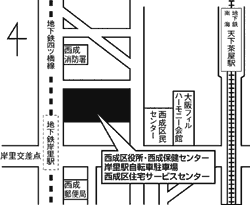|
|
||||||||||
|
||||||||||
| Nishinari ward Home > Ward overview / Ward overview | ||||||||||
 |
| Established on April 1, 1925 |
 Nishinari Ward stretches from the west side of Uemachi Terrace to the Kizu River. The western part of the district, which is believed to have been under the sea in ancient times, was gradually formed by sedimentation of the Kizu River and other landform changes, and then developed in later years. Nishinari Ward stretches from the west side of Uemachi Terrace to the Kizu River. The western part of the district, which is believed to have been under the sea in ancient times, was gradually formed by sedimentation of the Kizu River and other landform changes, and then developed in later years.
The old Kishu Highway, now Sumiyoshi Highway, runs north to south across the eastern part of the ward. The highway and its surrounding areas began to develop in conjunction with the growth of Sakai City. These areas were later called Tengachaya (tenga means “supreme feudal lord” and chaya means “teahouse”) because Toyotomi Hideyoshi stopped at a teahouse on his way to the Sumiyoshi Grand Shrine and the Sakai Mandokoro. The site of the old teahouse is now preserved as an historical site officially designated by Osaka City. During the Edo period, Nishinari Ward belonged to an area called Hataba Hachikason, meaning “a group of eight villages of Hataba”, and developed as a vegetable supply center for Osaka Sango, now Osaka City. Currently, Nishinari Ward is highly populated, with easy access to transportation via highways including National Route 26 and 43, subway lines, JR lines, and private railway lines. However, with a history of development as a town of commerce and industry as well as of ordinary people, Nishinari Ward still has an old town atmosphere that values human relationships. Located in Kishinosato 1-chome, a portion of the site of the defunct Nankai Tengachaya Rail Car Plant, the Osaka Philharmonic Hall – Japan’s largest orchestra rehearsal venue – is the base for the Osaka Philharmonic Orchestra. In the south of central Nishinari Ward, there is the Minamitsumori Sakura Park and Sports Ground located in Minamitsumori 1-chome, which contributes to the promotion of sports. |
 The Bush Clover has long been a symbol of the ward; this attractive flower used to grow wild along the sides of the Kishu highway that runs north-to-south through the ward. The bush clover enjoys an image as the flower of the people, and the manner in which the plant's small branches and flowers grow together give an image of banding together and cooperating for the collective good. These qualities were considered to make the Bush Clover the most appropriate flower to represent Nishinari-ku. The Bush Clover can be seen at places such as Tengachaya Park in the ward. The Bush Clover has long been a symbol of the ward; this attractive flower used to grow wild along the sides of the Kishu highway that runs north-to-south through the ward. The bush clover enjoys an image as the flower of the people, and the manner in which the plant's small branches and flowers grow together give an image of banding together and cooperating for the collective good. These qualities were considered to make the Bush Clover the most appropriate flower to represent Nishinari-ku. The Bush Clover can be seen at places such as Tengachaya Park in the ward. |
 Super Ponpoko Jagapee Nishinari-kun was designed in 1996 to mark the 70th anniversary of the establishment of Nishinari Ward. Super Ponpoko Jagapee Nishinari-kun was designed in 1996 to mark the 70th anniversary of the establishment of Nishinari Ward.
Osaka City has twenty-four wards and many of them now have their own mascots. However, Nishinari-kun was the first. Children in Nishinari gave the mascot a rather long name: Super Ponpoko Jagapee Nishinari-kun was named after its head that looks like a jagaimo (potato), its body and tail that resemble those of a Japanese raccoon dog, and its cape that gives an image of Superman. Nishinari-kun is a public relations representative of Nishinari Ward. Please say “hi” to Nishinari-kun when you see him. |
| Nishinari-ku ward office |
 1-5-20 Kishinosato, Nishinari-ku, Osaka 1-5-20 Kishinosato, Nishinari-ku, Osaka06-6659-9625 (General Affairs Section) |